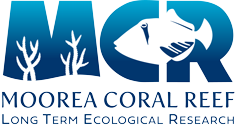Year:
2019
Authors:
Source:
Marine Ecology Progress Series
Abstract:
Coral microbiomes are sensitive to multiple physical and biotic stressors that can increase host susceptibility to dysbiosis, leading to bleaching and mortality. While the factors that drive coral dysbiosis are complex and still not well understood, a number of mechanisms may facilitate transmission of opportunistic bacteria. For instance, several marine invertebrates and fishes are suspected to act as microbial vectors through corallivory, as well as via fecal transmission of microbes. Here, we used a factorial manipulative experiment to test the interactive effects of feces deposition by a common surgeonfish Ctenochaetus striatus and mechanical wounding (mimicking corallivory) on microbial communities of the coral Porites lobata. We found that exposure of unwounded and wounded corals to fish feces induced an increase in microbial richness and diversity of 1.5- and 2-fold, respectively, and resulted in greater abundance of potential opportunists (e.g. Rhodobacteraceae, Verrucomicrobiaceae, Flavobacteriaceae, Vibrionaceae, Fusobacteriaceae). Many of these opportunists were also found in C. striatus feces. While microbial communities in corals exposed to individual stressors tended to shift back to their original composition at the end of the 48 h experiment, the persistence of potential opportunists (e.g. Vibrionaceae, Campylobacteraceae, Cohaesibacteraceae) when feces and wounding were combined indicates that impacts to the coral microbiome may be exacerbated when stressors interact. Our results suggest that fish feces may represent a novel route of transmission of microbes and/or facilitate the enrichment of potentially opportunistic and pathogenic bacteria within reef-building corals. Further, interactions with other common stressors such as corallivory might worsen these impacts, increasing dysbiosis and ultimately affecting coral health.
Volume:
631
Pages:
81-97
Publication Type:
Journal Article



